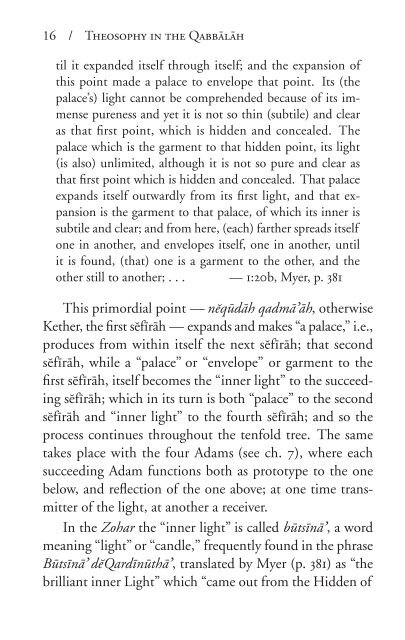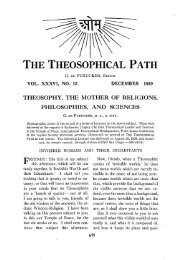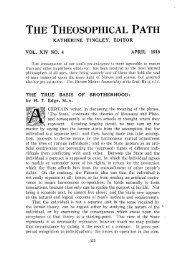Theosophy in the Qabbālāh - The Theosophical Society
Theosophy in the Qabbālāh - The Theosophical Society
Theosophy in the Qabbālāh - The Theosophical Society
Create successful ePaper yourself
Turn your PDF publications into a flip-book with our unique Google optimized e-Paper software.
16 / <strong><strong>The</strong>osophy</strong> <strong>in</strong> <strong>the</strong> Qabbãlãh<br />
til it expanded itself through itself; and <strong>the</strong> expansion of<br />
this po<strong>in</strong>t made a palace to envelope that po<strong>in</strong>t. Its (<strong>the</strong><br />
palace’s) light cannot be comprehended because of its immense<br />
pureness and yet it is not so th<strong>in</strong> (subtile) and clear<br />
as that first po<strong>in</strong>t, which is hidden and concealed. <strong>The</strong><br />
palace which is <strong>the</strong> garment to that hidden po<strong>in</strong>t, its light<br />
(is also) unlimited, although it is not so pure and clear as<br />
that first po<strong>in</strong>t which is hidden and concealed. That palace<br />
expands itself outwardly from its first light, and that expansion<br />
is <strong>the</strong> garment to that palace, of which its <strong>in</strong>ner is<br />
subtile and clear; and from here, (each) far<strong>the</strong>r spreads itself<br />
one <strong>in</strong> ano<strong>the</strong>r, and envelopes itself, one <strong>in</strong> ano<strong>the</strong>r, until<br />
it is found, (that) one is a garment to <strong>the</strong> o<strong>the</strong>r, and <strong>the</strong><br />
o<strong>the</strong>r still to ano<strong>the</strong>r; . . . — 1:20 b, Myer, p. 381<br />
This primordial po<strong>in</strong>t — nêqûdãh qadmã¿ãh, o<strong>the</strong>rwise<br />
Ke<strong>the</strong>r, <strong>the</strong> first sêfîrãh — expands and makes “a palace,” i.e.,<br />
produces from with<strong>in</strong> itself <strong>the</strong> next sêfîrãh; that sec ond<br />
sêfîrãh, while a “palace” or “envelope” or garment to <strong>the</strong><br />
first sêfîrãh, itself becomes <strong>the</strong> “<strong>in</strong>ner light” to <strong>the</strong> succeed<strong>in</strong>g<br />
sêfîrãh; which <strong>in</strong> its turn is both “palace” to <strong>the</strong> second<br />
sêfîrãh and “<strong>in</strong>ner light” to <strong>the</strong> fourth sêfîrãh; and so <strong>the</strong><br />
process cont<strong>in</strong>ues throughout <strong>the</strong> tenfold tree. <strong>The</strong> same<br />
takes place with <strong>the</strong> four Adams (see ch. 7), where each<br />
succeed<strong>in</strong>g Adam functions both as prototype to <strong>the</strong> one<br />
below, and reflection of <strong>the</strong> one above; at one time transmitter<br />
of <strong>the</strong> light, at ano<strong>the</strong>r a receiver.<br />
In <strong>the</strong> Zohar <strong>the</strong> “<strong>in</strong>ner light” is called bûtsînã¿ , a word<br />
mean<strong>in</strong>g “light” or “candle,” frequently found <strong>in</strong> <strong>the</strong> phrase<br />
Bûtsînã¿ dêQardînûthã¿ , translated by Myer (p. 381) as “<strong>the</strong><br />
brilliant <strong>in</strong>ner Light” which “came out from <strong>the</strong> Hidden of













